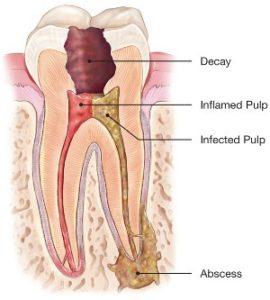
Looking at this diagram of the anatomy of a tooth, see the part of the tooth called the pulp. It is also known as the pulp chamber. It is a hollow part of the tooth in which there are blood vessels, nerves, and other connective tissue. It is the primary living part of the tooth. The cells that form the dentin are all along its internal surface. The pulp continues down the root(s) of the tooth as a narrow canal; hence the term root canal. The root canal contains blood vessels, nerves, and connective tissue just like the pulp.
But that’s not what people want to know about, when they ask about a “root canal”. What they want to know about is . . . What is Root Canal Treatment?
Like any other part of the body, the pulp and the root canal can become diseased. The most common cause of a diseased pulp and root canal is tooth decay – dental caries. If decay is not treated and the decay penetrates significantly into the tooth, bacteria from the decay enter the pulp via the cells of the dentin. The pulp becomes inflamed, and can then become infected. Once the pulp is infected, it is only a matter of time (usually not a very long time) until the infection spreads into the root canals, and eventually past the end of the tooth into the bone.
Depending on the extent of the infection, there are different symptoms that a person will experience.
Usually, when a tooth hurts without any provocation, and especially to heat and to pressure (i.e: chewing) it indicates that the pulp and root canal are completely infected.
That’s when Root Canal Treatment is often the treatment of choice in order to “save” the tooth, and allow it to continue to function in the mouth. Otherwise it might have to be extracted.
Other circumstances that could make Root Canal Treatment necessary include:
- Extensive (or repeated) restorative treatment for that tooth in the past. In other words, large fillings, or the presence of a lab-made crown.
- History of trauma: a blow to, or fracture of, the tooth, either recent or in the past.
- Periodontal (gum) disease that has seriously damaged the bone support.
Left untreated, an infected tooth will frequently stop hurting all on its own. But that doesn’t mean that the problem has been cured. Actually the opposite is true. The infection has become chronic, and may progress over time, into a chronic abscess, fistula, or even a cyst. And some of these may be without symptoms, but damage to the bone and the soft tissues continues just the same.
So how does Root Canal Treatment help?
To use an analogy: If you had a hole in a wall in your home that you wanted to eliminate, there are two things you could do. You could patch up the hole, and paint the patch, and voila! The hole is gone. Or . . . you could take down the wall, and the hole would also be gone. But, there would be a different problem.
Similarly, with an infected tooth, you could take out the tooth – that’s like taking down the wall. Usually, that leads to other problems. Or . . . you could eliminate the hollow space in the tooth, and voila the infection is gone – that’s what Root Canal Treatment is.
Root canal treatment consists of:
- Accessing the root canal system (the pulp and the root canal(s).
- Thoroughly cleaning, shaping, debriding the root canal spaces, eliminating the infection.
- Completely obturating the prepared root canal space (i.e: filling it up) with a special material that conforms to the intricacies of the space, and seals the tooth at the very tip so that no infection remains in the tooth, and none spreads beyond the end of the tooth into the bone.
Then. . . the tooth can be restored, usually with a crown to prevent fracture of the tooth. And, such a tooth can even be used to support a fixed or removable restoration.
With the techniques that are used today, often root canal treatment can be completed in one appointment. But, some teeth have 2, 3, or even 4 or 5 canals. Each of them must be thoroughly prepared and obturated. So, in some circumstances more than one appointment is necessary.
Thanks to the excellent local anesthetics that we use, having root canal treatment is no more uncomfortable than having a tooth restored or extracted, although it does take longer.
The fees for Root Canal Treatment are often covered by dental insurance plans. Some plans cover only a portion of the fees, and some cover almost the entire fees.
It is important to bear in mind that root-canal-treated-teeth are more brittle and more prone to fracture. That is why we almost always recommend a lab-made crown as the best protection against fracture. The best protection, but even that is not 100% protection.
If you have any questions about Root Canal Treatment, or any other kind of dental treatment please do not hesitate to ask any member of our professional staff.
